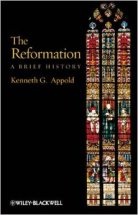
Kenneth G. Appold, The Reformation: A Brief History, West Sussex: Wiley-Blackwell, 2011. 203 pages.
Kenneth G. Appold’s book The Reformation: A Brief History is a collective book upon the survey of Reformation history. Through understanding of late medieval church life and ecclesiology, the progress of Luther’s Reformation, and the ‘rural’ reformation, Appold’s book provides a small, but dense recap of the Reformation throughout 15th and 16th century Europe. Kenneth G. Appold is an Associate Professor of Reformation History at Princeton Theological Seminary. Since this book is a ‘brief’ Reformation book, Appold uses a collection of mostly secondary sources to help support the snippets of his overview. He uses, for example, Alister McGrath, who is known for publishing Christian Theology: An Introduction and Hans-Jurgen Goetz, who wrote on Reformation Anabaptist histories and figures. Appold does acknowledge that the book, with its emphasis on a brief history, is a deterrent to a historian’s perspective. Even though Appold mentions this, he argues that a brief history allows a development of a synthesis for the individual scholar and reader on the narrative scope of the time period. (p. viii-ix). Appold wanted to share his synthesis from this work, even though some areas will not be covered.
Appold’s structure of the book is chronological in its historical presentation. He first decides to outline the overview of the book by explaining the period before the Reformation, and how late medieval churches, customs, and societies had affected the forecast of ecclesial reform. One of the aspects of the affected forecast was church liturgy. According to Appold, the churches relation to the community and vice versa was ambivalent in attitude. (p. 5) There was not a lot of care for church discipline and worship, and peasant involvement within the church was usually for personal and social reasons. Attendance to the mass is common and the only important moment within the mass is the lifting of the host (the body of Christ) and the participation of the Eucharist.(p. 5) The common layperson, according to Appold, did not see the clergy as a person of religious authority but of religious instigation. Church administration and the performance of the sacraments were the only duties that the clergy had in the late medieval Catholic Church. Pastoral care was limited or even neglected and their relationships among laypeople were controversial and strained. The church was not the place to seek a religious experience. It was through pilgrimages and the veneration of icons and saints that an individual could receive a religious experience.
Even though Appold provides more reasons to the forecast of the Reformation, his overview example of Church liturgy provided a clear opening for his explanation on the direction to reform. The first section of the book is a solid foundation for the direction of his proposal– that the synthesis of understanding church life and church practices from the late to the early modern period was necessary for the development of a historical consensus. The second section of the book is Appold’s explanation of Luther’s Reformation. He dedicates the whole second section to the progression of Luther, which shows the reader his stress on the importance of Luther’s Reformation. Despite Appold’s description of Luther’s life and engagements, one area that Appold describes systematically is Luther’s theology. One example is Appold’s explanation of Luther’s epiphany on justification. Even through a condense book, Appold decides to add and reflect on Luther’s viewpoint on justification by referring back to early church scholarship and not just Luther’s exegesis. Appold displays Luther’s pursuit of “ad fontes” within the church, and not his own created ideas. Appold references back to the controversy between Augustine and Pelagius during the 5th century, in which he argues that Pelagian concepts were in use within the Medieval church until Luther’s time. Appold describes the relationship through this description:
“While Augustine’s position prevailed theologically, Pelagian tendencies continued to resonate in the practical context of medieval missions and Christianization. The notion that people are free to choose a more moral life fits more conveniently with the kinds of exhortations to discipline that marked the mission effort.” (p. 72)
Luther was convinced that Augustine’s theology on justification, was the correct, biblical position, was not implemented within the Catholic Church. Augustine held the view that our justification was not reliant upon our individual powers or progressions, but on the full grace of God. The Pelagian view says that God already gave the disposition for humanity to sin or not to sin, meaning that God does not intervene with our justification. Instead, we have to merit for our justification. Appold’s synthesis of connecting early church ideas to the Reformation helps reveal that the Reformation was not a radical revolution, but a return to an early church foundation.
Last, Appold explains the ‘rural’ reformation. Appold admits that studies in Reformation history have neglected the ‘rural’ areas of the reformation and that “the majority population of Europe was not in the cities but in the countries.” (p. 103) In retrospect, the Reformation was not influential in scope, but its ideas had an impact on the medieval peasant’s status quo. This led to attempts to rural reform of both church and government. Appold references some important figures within the movement like Hans Muller–the leader of the Black Forest Band– and the creators of the Twelve Articles– Christoph Shappeler and Sebastian Lotzer– who wrote the articles to “declare a declaration of independence amongst peasants and church orders.”(p. 108) Appold synthesizes the rural reformation in order to show that the Reformation was not only a church issue, but a governmental issue. He then reflects back on how the church operates throughout Western Europe and its impact on the people.
Appold’s book helps expand our understanding of Reformation history. While this work lacks references to the English Reformation, Appold’s goal is to present a synthesis of the problem of church unity, which was fully addressed through Luther’s reformation. (p. ix) He sets out to address the main issue of the Reformation, church unity. He focuses on the Lutheran movement to explain the reiteration of church unity throughout Europe. The book is not a comprehensive book of Reformation history, but a reflective book on the progression of Reformation history. He wants the readers to understand the importance of synthesis when dealing with a certain topic or argument in history and that mass detail should be compatible with brief detail. Appold’s book should be very fitting to a Reformation student and scholar, and in my opinion a recommended book for revisiting the Reformation, and how to synthesis a historical overview into a collective view.
By Kou Xiong–Wheaton College




